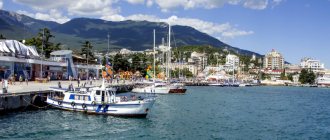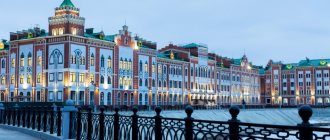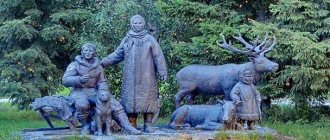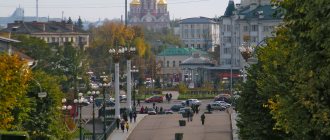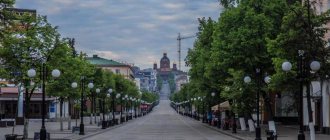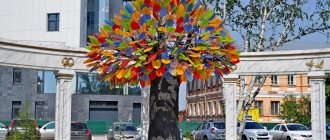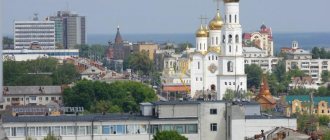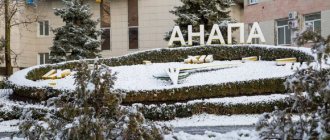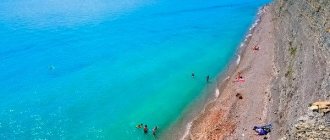Article creation: 07.08.2018
Last update: 29.10.2021
The architecture testifies to the youth of the city
There are not many cities in the world that are located above the Arctic Circle. Apatity is one of them. In terms of the number of polar inhabitants, it ranks honorably fifth. The city is picturesquely spread out on the banks of the Belaya River. It is located between the Khibiny mountains and Lake Imandra. In the Murmansk region it ranks second in size, second only to Murmansk.
Between Imandra and Khibiny
Apatity is the center of an urban district in the Murmansk region. The district also includes the Khibiny railway station and the nearby village of Tik-Guba, which was founded by special settlers in 1924. The first airfield on the peninsula was built in this place. There was also a hydroairfield, where the water surface of Lake Imandra was used for landing aircraft. The railway leading to Murmansk passes through Apatity.
The mineral apatite, after which the city of Apatity is named
The city is located on a flat plain, so the highest point is Sparrow Mountain, the height of which does not exceed 80 m. Small forests adjoin the city on three sides. The nearest city is Kirovsk, which is only 12 km away. From Murmansk to Apatity – 157 km. The cities are connected not only by the railway, but also by the federal highway R-21 “Kola”.
On the one hand, the city is closed by the Khibiny Mountains, and on the other, on the contrary, Lake Imandra opens to all winds. There is no doubt that such a disposition creates the preconditions for a special microclimate. Winter here lasts 5-7 months, but is mild. The average temperature in the winter months hovers around -13 degrees. For an area belonging to the Far North, this is not much. The average summer temperature is +14 degrees. The polar day lasts from May 20 to July 27, and the polar night lasts from December 15 to 28.
Tourism development
Considering that Russian tourists are attracted by the unique beauty of the Kola Peninsula, which contains an extensive system of lakes, a number of mountain ranges, several nature reserves, and the largest city of the Kola Peninsula by area, Apatity, is located in this region, much attention is paid to urban infrastructure for the development of tourism.
There are seven hotels operating in the city year-round. The most popular and hospitable of them, according to reviews from tourists, is considered to be the Kola Scientific Center of the Russian Academy of Sciences (“Hotel of the Kola Science Center”). It is located in Apatity in Akademgorodok, on a street named after the founder of geochemistry, Alexander Fersman.
White crossing
The North has always attracted with its riches, the development of which required transport routes. First, trails appear, followed by roads, and only then comes the turn of railroads. It took a year and a half to build the railway from Petrozavodsk to Murmansk. The grandiose construction was completed in 1916.
A hundred years ago, geologists discovered the largest deposits of nepheline ores
At this time there was no trace of Apatity. Only on one of the stages near Lake Imandra did a crossing called Bely appear. The name was given after the local Belaya River. Now this is the Apatity-1 railway station. The settlement of Apatity appeared on maps only ten years later, when geologists discovered the largest deposits of nepheline ores. In 1926, only seven people lived in the village! For comparison, the city now has 55 thousand residents.
It so happened that during the war the Kola Peninsula found itself cut off from the Big World. Residents of the Arctic were trapped and were forced to produce everything they needed for life themselves. Apatity then included the large state farm "Industry". Thanks to him, the city has become one of the main suppliers of food for the Arctic. Vegetables were grown not only on state farm fields, but also in their own gardens.
Apatity is connected to the “mainland” by the federal highway “Kola”
In the 50s, they decided to turn the village into a city. At that time, in addition to the state farm, there was a processing plant here. The population was growing. The first multi-storey building was built in 1956. Then they began to grow like mushrooms. Scientists from the Kola branch of the Academy of Sciences moved here. Apatity became a city in 1966. In the 90s, the expansion of the city stopped, life was barely glimmering. The situation has changed only in the last decade.
Apatity population
In the 20th century, the population in Apatity grew steadily. Peak at 88 thousand people. was noted in 1989. Since the 90s. the number of citizens is gradually decreasing. In 2022, 55 thousand people were recorded. Despite this, Apatity continues to hold a stable position in the TOP 5 cities of the Arctic. In the all-Russian ranking he is ranked 300th.
| Year | Population, thousand people |
| 1939 | 4409 |
| 1959 | 13958 |
| 1979 | 62010 |
| 1989 | 88026 |
| 2000 | 69500 |
| 2010 | 59672 |
| 2019 | 55201 |
Let's have fun in the northern way
Tourists are attracted to these places, first of all, by Imandra and Khibiny. Apatity, thanks to its developed transport infrastructure, is a transshipment base for skiers and alpine skiers, lovers of rafting and hiking, as well as fishermen. 14 species of fish classified as commercial are caught in the lake. In winter, kite races are held on its icy surface.
The immediate surroundings of the city are characterized by an industrial landscape
People come to these places to see with their own eyes such a rare colorful phenomenon as the northern lights. In the suburb of Tik-Guba on the banks of the Imandra there is a camp site and a beach. In the vicinity of the city there is a botanical monument “Cedars and larches of the Khibiny”. The Yokostrovskoye Kintishche is of interest to tourists. Expedition tours are organized to the legendary Sami churchyard.
Lake Imandra
Rock gardens are not only found in Japan. The residents of Apatit also decided to acquire such a landmark by establishing a Geological Rock Garden in the city center. Samples of rocks and minerals that are represented in this region of the country are exhibited in the open air. The exhibits are provided with explanatory signs.
The Geological Museum is dedicated to the same topic. There is an exhibition here telling about the drilling of the Kola superdeep well. The exhibition “Decorative and facing stones of the Kola Peninsula” is of great interest.
There is also the Museum of the History of the Development of the Russian North, where there are 7 exhibitions. There is everything here - archeology, the life of the Sami, and the peculiarities of the Kola Pomerania. There are three active churches in the city - the Holy Dormition, the Russian New Martyrs and Confessors, and the Iveron Icon of the Mother of God.
The mineral apatite is certainly represented in all museum collections
The local history museum is housed in the building of the local Palace of Culture. Of interest here are permanent exhibitions dedicated to the mysteries of Seydozero, Kola minerals and northern folk crafts. The House of Culture annually hosts sports ballroom dancing competitions, which are romantically called the “Polar Ball”. Among the interesting events is also Fr. Here you can buy not only beautiful stone products, but also rare collectibles.
Fans of active recreation in Apatity are offered rafting on mountain rivers and lakes on catamarans and rafts, bicycle tours, and city tours. In winter, snowmobile safaris, mountain snowshoe treks and alpine skiing are of interest. A winter highlight is hiking to the Khibiny Mountains with an overnight stay in a traditional Sami snow shelter. With the arrival of winter, the Ice Sculpture Gallery appears in the city center.
Husky ride
The active amusement park "Khibinium" offers dog sledding, a rope park and a shooting range where you can shoot with a crossbow and bow. There is a petting zoo called Pegasus, where they offer horse riding lessons. You can also ride horses at local equestrian clubs. And at the recreation center “Ogni Imandra” there is an ethnographic village of the peoples of the Far North. Sami sleigh rides, feeding reindeer, drinking tea in a tent near the fireplace - it's all here.
Khibiny mountain range
Fans of ski mountain tourism spend their leisure time on the slopes of the Khibiny mountain range, between which the territory of the city of Apatity is located. These rocks are approximately 390 million years old.
Mount Yudychvumchorr is considered the highest (1200 m above sea level). On it, the snow retains its properties for alpine skiing from the beginning of October until the last days of June.
A special feature of the climate in these mountains is that in August tourists can observe an amazing natural phenomenon - the glow of the upper layers of the atmosphere (northern lights).
Holy Assumption Church
Tourists can attend the service. To do this, it is worth visiting the Holy Assumption Church, which is located on Lesnaya Street.
Until 1994, there were no church buildings in the city of Apatity. At the request of the Murmansk diocese, the city leadership agreed to rebuild a one-story store into such a structure.
Thus, the first church in Apatity, which received its name in honor of the Dormition of the Mother of God, began functioning on March 30, 1996.
Buddhist Stupas of Enlightenment
According to the teachings of Buddhism, a stupa is an architectural sculptural structure. It is based on the traditions of the Tibetan religion, which is considered a world religion, along with Islam and Christianity.
There are eight types of stupas in total, but the Stupa of Enlightenment is considered the main type; it represents overcoming all obstacles to the revelation of human mental abilities.
It is believed that the founder of Buddhism was a real person named Siddhartha Gautama. He tried to find in reflection and prayer the nature of all human troubles.
After some time, insight came, then he found the answer to all his questions.
People called him Buddha (enlightened one), and Gautam began to preach Buddhism.
Tourists interested in the history of this ancient religion can visit two Buddhist Stupas of Enlightenment, which are located where Apatity is located. Such monuments are the only ones in the Arctic.
Museum of the History of the European North
On Fersman Street (Akademgorodok) there is a museum-archive of the history of the development of the European North, which attracts tourists with its exhibitions.
The idea of creating the exhibits belonged to the author of scientific works on the history of the Far North of Russia, Boris Koshechkin.
The basis of the museum exhibitions were documents, photographs, and various objects related to the life and activities of the people living on the territory of the Kola Peninsula.
After some time, the city council decided to create a museum archive in the building in which it has been located in the city of Apatity since 1974 to the present day.
Tourists can examine geographical maps, ancient books and many other ancient objects related to the life of the people of the Arctic. Museum visitors pay attention to examining medieval utensils that belonged to Novgorodians who moved to the Kola Peninsula in the Middle Ages.

